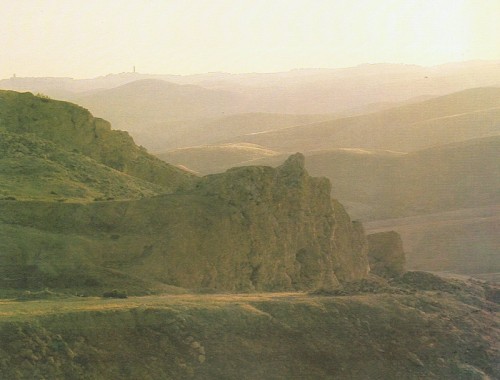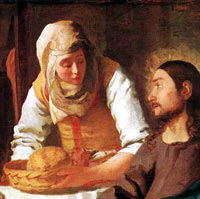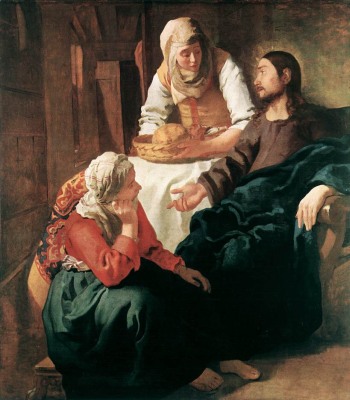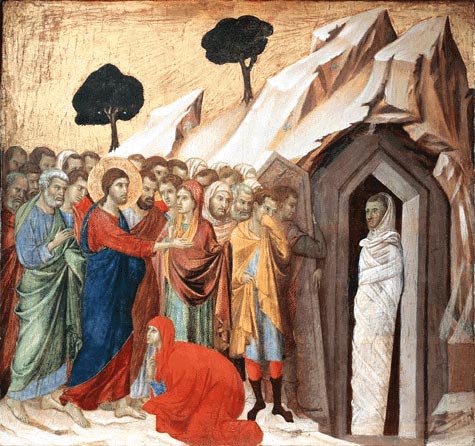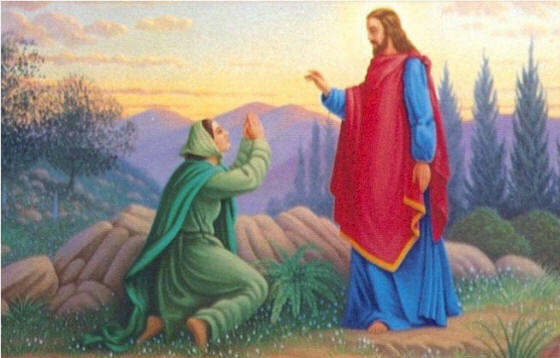JOURNEY TO BETHANY
THE RAISING OF LAZARUS
After being in Jerusalem last week where in the majestic temple shining on Mt. Zion Jesus preached that He is “the living water” for all who are thirsty (Jn. 7. 37) let us make the short journey to Mt. Olives where nestled in the south-east side is the village of Bethany where Mary, Martha and Lazarus had lived. Here Jesus loved to come and visit. It was always a time of refreshment and companionship.
It is one of the most moving scenes in all of scripture. After David’s journey from the city, he had made his own, he reaches the Olivet, tired and weary. It is a pitiful site as He sits and weeps – weeps in penitence, as do the people who follow Him. All this happens overlooking the valley of the Kidron that valley Jesus will also cross to be betrayed.
It is here that David learns that Ahithopel, one of David’s counsellor had gone over to Absalom, but who when his counsel is rejected by him, knew the coup d’etat would fail, and he went and hanged himself (the only other person to do so in scripture beside Judas –II Sam. 16, 31; 17. 1 – 23). His advice had been rejected as from Mt. Olivet David sent Hushai to Absalom with advice that vetoed Ahithopel’s that probably would have given success to Absalom but he was not politically astute to realize this.
She would never have Mary tear herself away from the Master so she approached Jesus. Don’t you care if my sister leaves me to do all this kitchen work by myself? Compassionately Jesus embraces her saying, “Martha, Martha, you do fuss over many things, but really only a few things are necessary in life.” Indeed “only one” really is. Mary knows that “only one”, so do not take that away from her (Lk.10.39 – 42). What did Martha think about that? We are not given any indication.
Mary loved to sit at the feet of Jesus. Just being with her Lord she grew in her sensitivity towards Him, so much that when He came to visit their home “six days before the Passover” as the family were having their meal, their last together, Mary left the couch to anoint Jesus’ feet.
In her hand a bottle of perfume
The best nard possible
Not with a drop or two.
A whole bottle she poured - Lavishly.
Her hands gently and lovingly massaged
perfumed nard into your dusty feet.
Feet that dustier would come
along the via Dolorossa.
Mary’s long-flowing hair
wiped your perfumed feet.
The lavish scent lingered
during the evening meal .
In those hours of torture close by
Mary’s kind caresses lingered
soothing away Your tiredness
with her lavishness and love.
Mary loved you deeply.
Anointing you for burial
With a love only she could give
to farewell her Lord.
M.D.
In between these two events in the Bethany home we have this Sunday’s reading – the raising of Lazarus, the last of the signs in John’s Gospel.
This reading is the culmination of Jesus’ ministry in the first part of the Johannine gospel. It is also a progression in the life of a Christian. The Samaritan woman exemplified the beginning of faith for a Christian; the man who received his sight manifested his enlightened faith about who Jesus is by confrontation and now in this account we are going to see how faith is deepened in the face of death, that last enemy to be overcome as Paul tells us.
In the Johannine tradition this is our introduction to this family. Although Martha obviously believed that Jesus is the Son of God and even though she confesses to Jesus that she believed in the resurrection of the body, she had not understood what Jesus had taught about eternal life – death does not terminate it. It took this miracle by Jesus for her to grow in that understanding.
Please note too it is the raising of Lazarus that determined the mind of the Sanhedrin that Jesus must die.
Raising of the dead has also occurred in the Synoptic tradition, notably the raising of the son of the widow of Nain in Luke’s gospel (Lk. 7. 11 – 17), and the raising of Jarius’ daughter in Mark (5. 22 – 43). So this raising is not unique.
Let’s read the passage Ch. 11. 1 – 44.
Act I -Scene I – Jesus discovers from Martha and Mary that Lazarus is dead.
The news reaches Jesus from Martha and Mary that their brother is dead. Immediately Jesus’ reaction is to see this as another opportunity to for the glorification of God “as this sickness is not to end in death.” It will be a means of giving life. Yet Jesus purposely lingered two days before setting out for Bethany. When Jesus told the disciples He was returning into Judea they were staggered. How could he do such a silly thing they thought? After all, the authorities had just tried to stone Him (10.31). So as Thomas spelt it out, “Let us go with him, so we can die with him.” Did Thomas really have any idea of what he was saying?
Act II
Scene I – Bethany – Martha’s profession of believeth
On full stage are the Jews who have come to comfort the two sisters.
Scene II – Martha and probably Mary meet Jesus a little way from their home. Martha blurts out, “If you had been here, my brother would not have died.” However she shows sufficient faith in Jesus to know that anything He asks, God will grant. Yet when Jesus informs her, that her brother “will rise again”, her reply illustrates that she misunderstands. Her profession of the resurrection on the last day was already a belief shared by Pharisees and others at this time.
Our Lord’s reply that He is the resurrection means eternal life even though one may die. (Even Lazarus will die again). What it actually means in the Johannine theology is that whoever receives the gift of life through belief in Jesus will never die spiritually.
When Martha responds to this, notice how similar this is to the Samaritan woman at the well. Jesus will do for her what He did for the Samaritan woman convince her of that statement by raising Lazarus just as His time with the Samaritans in their village brought the woman and other villagers to a conviction.
(in scripture passage this is followed by almost a duplicate with Mary).
Act III – The raising of Lazarus
Scene I – the foreplay
Where is he? Jesus asks? Notice we have those two verbs that run through this gospel “Come and see” but the reverse this time – not to see Jesus as such but what will lead to the greatest of the signs in order to believe – the raising of Lazarus.
At the thought of seeing his friend dead, we have a very tender side of our Lord revealed, simply expressed, “Jesus wept.” Obviously the Jews who had come to comfort had remained, and seeing the love Jesus had, remembered what He had done for the blind man. Couldn’t He have done the same for Lazarus? Once again we see how closely linked is light – life –love in this gospel.
Scene II – the burial site
As the stone is removed, Martha again shows her practical side again – Lord, by now my brother would stink. Just as /he did with the woman at the well Jesus ignored the periphery and went to the heart of the situation. If you believe you will see “the glory of God”.
Before the sisters and the Jews, Jesus lifts up his hands in prayer to the Father to thank Him that He always hears the Son and therefore He is seeking the power to raise Lazarus from the dead. Notice this is typical approach for a Jew praying. By praying to the Father it recalls the Johannine belief that Jesus never does anything by Himself, He always works hand in hand with His Father. It is indeed a prayer of rejoicing for He knows that His Father will do this.
As the Father’s will must be done, Jesus shouts, “Come out Lazarus!”
Lazarus comes out, still bound with his grave clothing. He has to be untied. Note the difference we have here with Jesus when He will rise – the grave clothes are left behind in the tomb. Lazarus has only been raised to earthly life – he must die again. Indeed immortality cannot come until Jesus is risen.
It was this raising of Lazarus that led many Jews to believe in Jesus and for that reason the authorities wanted to arrest Jesus. For Martha and Mary they truly know that Jesus is the Christ and they understand the meaning of life eternal that lives on after the grave.
OUR JOURNEY TO BETHANY
What do we focus on as we arrive in our journey to Bethany and to the home of Martha, Mary and Lazarus? Perhaps we may feel a little envious of the amount of time they shared with our Lord. Yet from Mary’s example we know we can share as much time as we want by simply sitting at his feet. As we approach Holy Week to sit and be silent and to soak in the Lord’s presence will help us to undergo something of that last week of our Lord’s life.
The Jews who came to comfort Martha and Mary help us to realise how sensitive we must be to the needs of our neighbours and more particularly the elderly and sick in our parish who may live far from us.
Yet on this journey this episode challenges us to see what stage of faith we are at? Like Lazarus we will die too but will we confidently believe that Jesus has risen and therefore we shall too, or will there be doubts? Is it really true? What if there is not anything at all - just a black hole after death? As Paul puts it, “if Christ has not risen, then we of all people are the most miserable.”
Death is the one event in life each one must enter and through alone. We began Lent with those words, “Thou art dust, and to dust shall thou return” Perhaps during this Lent we have not thought too much about death – our death and preparation for it. Now is a good the time to do that as we hang onto those words of Jesus, “I am life!” Yet more importantly we believe there is a place where there is no more weeping and no more tears. We shall reap in joy!
Marianne Dorman
Return to Index
To Lent VI
SIX DAYS BEFORE THE PASSOVER
Jesus loved His friends,
in Bethany they lived.
A last visit I must to
Mary, Martha and Lazarus.
A little while ago
Lazarus had died.
You were in Jerusalem
Only if You had been here!
At last you come!
What good news to Martha’s ears.
Your brother will rise!
“I am the resurrection and the life.”
Now sharing this last meal
Lovingly prepared by Martha.
Mary’s mind as always
Focused on holier concerns.
She loved her Lord dearly
Not bothered with food
She knelt at His feet
Something she had done so often.
(Didn’t her sister scold her so!)
